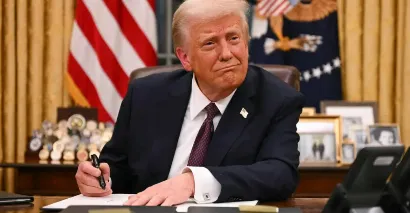Key Highlights
The landscape of skilled migration to the United States has been thrown into turmoil following the announcement of a massive, unprecedented fee hike for the H-1B visa program. Weeks after the Trump administration declared a $100,000 one-time fee for new H-1B petitions, a powerful coalition has struck back. This coalition, comprising unions, educators, religious organisations, and nonprofits, has filed a landmark federal lawsuit aimed at immediately dismantling the new policy.
The action represents one of the most significant legal challenges to the administration’s restrictive immigration policies concerning highly skilled foreign professionals. The plaintiffs argue that the fee, designed as a revenue measure, is unlawful and threatens essential services across the country.
The Legal Challenge: A Battle Over Presidential Authority
The lawsuit, filed in the Northern District of California, hinges on a fundamental question of constitutional and administrative law: Does the Executive Branch have the authority to impose such a substantial fee unilaterally? The plaintiffs contend that the administration’s actions are a clear overreach, bypassing established legislative and regulatory procedures.
The severity of the fee is seen by critics as an attempt to dramatically reshape the H-1B program without securing the necessary mandates from Congress, a body constitutionally tasked with controlling the nation’s revenue measures.
Congressional Approval: The Plaintiffs' Primary Stance
The central legal argument asserts that the President acted outside the bounds of his authority by implementing a major revenue-generating measure without a clear mandate or approval from Congress. According to the plaintiffs, any fee intended to fund government activities or impose a financial barrier of this magnitude must be legislated, not decreed via proclamation.
This requirement is not a mere technicality but a safeguard against unchecked executive power.
-
The lawsuit characterizes the fee as an unconstitutional revenue measure.
-
It claims the President has no statutory basis to impose such a substantial charge.
-
The coalition is fighting to uphold the separation of powers inherent in the US system.
-
They argue the fee is a tax in function, requiring legislative action.
The Arbitrary and Capricious Charge
Beyond the issue of Congressional power, the coalition contends that the administration bypassed the crucial regulatory process required for major policy changes. The lawsuit describes the decision as “arbitrary and capricious,” a specific legal term used when an agency makes a decision without relying on evidence or following required procedures.
By sidestepping the standard notice-and-comment rulemaking process, the administration allegedly ignored the potential economic and community impact of the policy. This failure to properly assess the consequences forms a key part of the legal offensive, suggesting the policy was implemented hastily and without due consideration.
Also Read: H-1B Cap Reached for FY 2026: What’s Next for Applicants?
A Coalition of Concern: Unions, Educators, and Nonprofits Unite
The diversity of the plaintiffs highlights the broad-ranging concern across various sectors of the US economy and society. The coalition includes entities that traditionally rely on highly specialized foreign talent, not just large technology firms often associated with H-1B usage.
The unity of this group—unions, typically focused on protecting domestic jobs, standing alongside educational and religious organizations—underscores the alarm caused by the $100,000 levy. They claim the fee would cripple institutions that serve the public good, where budgets are often constrained.
Protecting America’s Vital Sectors
In a joint statement, the groups warned that the federal government completely “ignored the impact this would have on communities across the country.” They emphasized that the organizations most dependent on skilled foreign professionals are often those providing essential, non-profit services to the public.
This dependence is particularly pronounced in fields where domestic shortages exist, such as specialized medical professionals or educators in underserved areas. The $100,000 burden is simply insurmountable for many of these critical institutions.
The Impact on Small Businesses and Hospitals
One of the most concerning aspects, according to the lawsuit, is the disproportionate effect the fee will have on smaller entities and essential service providers. Hospitals and schools often utilize the H-1B program to fill niche roles vital to their operations.
-
Hospitals rely on foreign-trained doctors and nurses, especially in rural or high-need urban areas.
-
Educational institutions seek scholars and specialized faculty whose unique skills may not be readily available domestically.
-
Small businesses cannot absorb a five-figure fee for a single employee, making international hiring prohibitively expensive.
The plaintiffs argue that this fee will not only deter skilled migration but will actively harm the quality and availability of essential community services by blocking access to necessary talent.
The White House Defence: Curbing H-1B 'Abuse'
In response to the legal and public backlash, the Trump administration has defended the policy by framing it as a necessary measure to protect the American workforce. A key part of their rationale centers on the argument that the H-1B program has been "abused," leading to job displacement for American citizens.
The White House position asserts that the program, originally intended to fill critical skills gaps, has instead become a tool for companies to hire cheaper foreign labor, thereby undermining domestic wages and employment opportunities. The hefty fee is presented as a deterrent to this alleged misuse.
Data Behind the Policy: The Rise of IT Jobs
To support its claims of abuse, the administration released a fact sheet citing specific data points related to employment trends within the Information Technology (IT) sector. This data was presented to justify the necessity of a sharp financial barrier to entry.
The White House referenced a significant increase in the proportion of IT jobs filled by H-1B visa holders over nearly two decades:
-
The proportion of IT jobs filled by H-1B visa holders was approximately 32% in Fiscal Year 2003.
-
This figure has allegedly surged to over 65% in recent years.
The administration used this dramatic rise as evidence that the program was excessively utilized and required drastic measures to ensure American workers were prioritized in the job market, asserting that the policy is a job-saving measure.
Also Read: F-1 and H-1B Visas: Once the Safest US Path, Now Fraught with Risk
Clarity Amidst the Confusion: Defining 'New' Visas
Following the initial proclamation, significant confusion erupted among US employers, international workers, and legal counsel regarding the exact scope and applicability of the $100,000 fee. Companies worried about employees abroad and the immediate impact on global operations.
White House Press Secretary Karoline Leavitt quickly moved to clarify the specific terms of the new rule, aiming to quell some of the immediate panic. She confirmed that the fee is a one-time charge and its application is narrowly defined, primarily targeting those just entering the H-1B system.
Relief for Existing H-1B Holders
The key clarification provided significant relief for the large population of foreign workers already contributing to the US economy under the H-1B program. The policy explicitly does NOT apply to several categories of current or renewing visa holders.
Leavitt specified the following exemptions:
-
It is not an annual fee; it is a one-time charge applied to the petition.
-
It applies only to new visas, meaning the first-time petition for an H-1B.
-
It does not affect renewals or extensions of existing H-1B visas.
-
Current H-1B holders who are abroad will not be charged the fee to re-enter the United States.
While this clarification eased concerns for existing workers, the immense cost still serves as a significant hurdle for any new foreign professional hoping to secure employment in the United States.
Also Read: Indian IT Industry Targets New Markets Amid Trump 2.0 H-1B Visa Changes
Conclusion
The lawsuit filed by the coalition of unions and educators against the $100,000 H-1B visa fee has ignited a critical legal and policy debate about the balance of power and the future of skilled immigration. This fee is seen by the administration as a tool to curb job displacement for Americans, grounded in data showing a spike in H-1B utilization in the IT sector. Conversely, the plaintiffs argue the move is an illegal overreach, circumventing Congress and endangering essential services like healthcare and education. The outcome of this case will not only determine the financial viability of the H-1B program for many employers but will also set a crucial precedent regarding the Executive Branch's authority to unilaterally impose sweeping revenue-generating immigration policies. The verdict will undoubtedly shape the competitive landscape for skilled labor for years to come. Visit TerraTern to know more!








